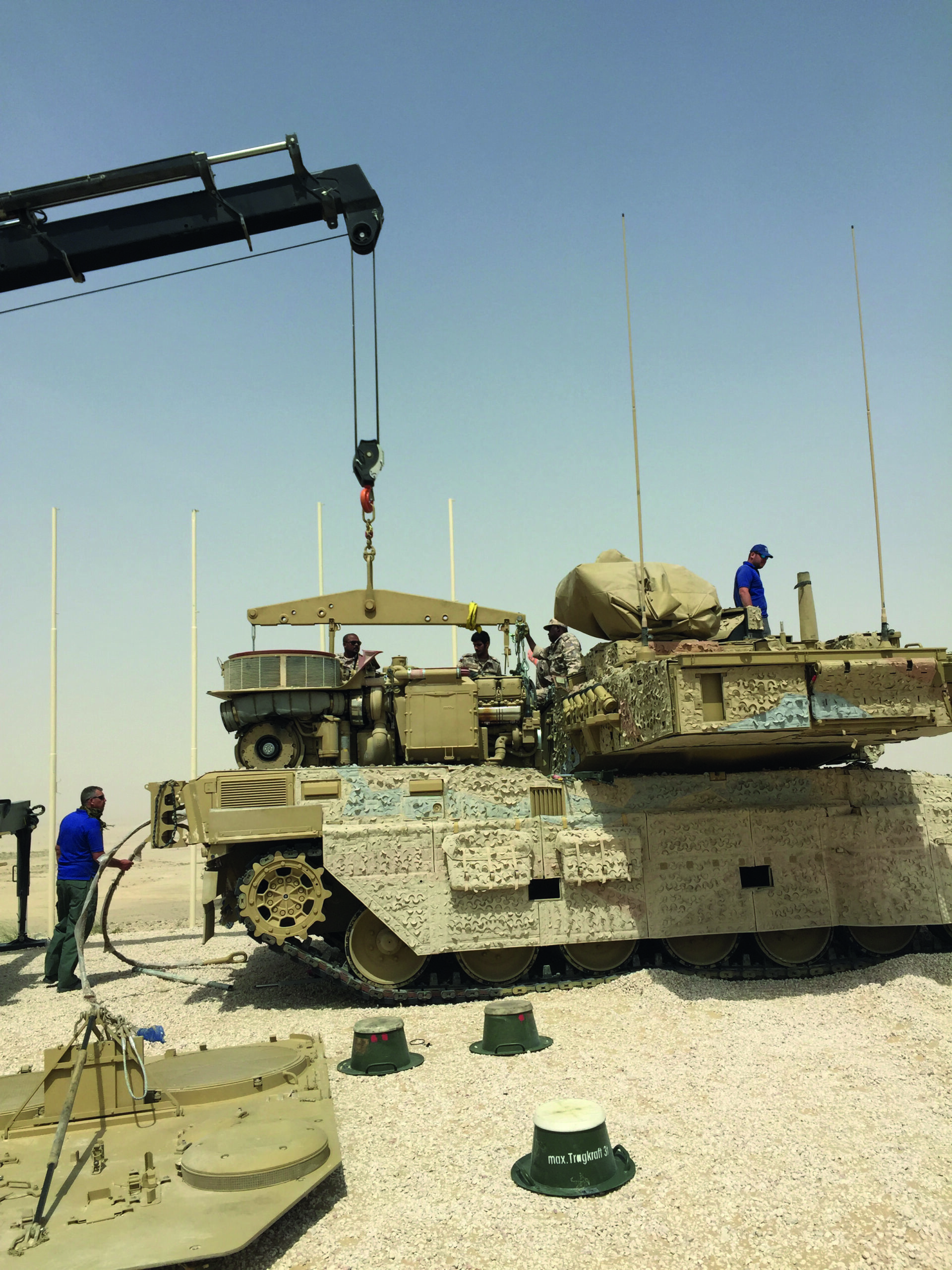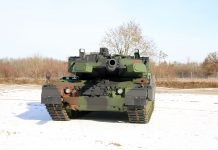Leopard 2 main battle tank: capability requirements and system-determining constraints
Volker Seibt
The Leopard 2 main battle tank (MBT) is the backbone of the armored force and the main weapon system for fighting enemy tank formations. It is particularly designed for highly mobile combat in direct duels with opposing battle tanks.

The ongoing development of tank combat technology and the resulting changing operational requirements require a continuous review and adjustment of the requirements and system design of the main battle tank. The MBT Leopard 2 was implemented as a consistent further development in all capabilities based on the experience with the MBT Leopard 1. This process is being continued on an ongoing basis, so that the A8 version now represents the most modern version.
Essentially, the design categories that determine the system remain unchanged
- Protectionthe crew and combat capability
- High tactical and strategicmobility
- Superior intelligence andeffect
In addition to the main features, the endurance of the system including its crew must also be taken into account when designing the system. So that the aspects
- Ergonomics / operation
- Inspection, maintenance and repairs
- Communication and leadership skills
also plays an important role.
Protection
Protection is one of the primary capabilities of the main battle tank to ensure crew survivability and system combat capability. There are a variety of threats that need to be withstood or, more recently, defended against, including ballistic projectiles, anti-tank weapons, mines and improvised explosive devices. To meet these requirements, the Leopard 2 is equipped with multi-layered armor that minimizes both kinetic energy and shaped charge effects.
Advances in armor technology, including composite armor, reactive and active protection systems, are constantly evaluated to continually improve and adapt vehicle protection to current threats. In the latest version of the Leopard 2, the TROPHY active protection system is used for the first time. To protect the crew against nuclear, chemical and biological threats, the Leopard 2 also has an NBC protective ventilation system. In the current variants, this has been optimized in terms of integration location (highest possible installation position to reduce particle entry) and type of integration (combination with combat compartment cooling system to increase ergonomics).
In order to be able to react to threats at an early stage, the timely identification of threats is an essential prerequisite. Depending on the equipment variant, the Leopard 2 has a detection or Warning sensors that, for example, detect the enemy's use of lasers or (guided) missile fire and display it to the crew as a warning message with the direction of the threat.
mobility
Tactical mobility is another important aspect that determines the operational capability of the Leopard 2. High speed and maneuverability enable the tank to react quickly to changing combat situations and maneuver effectively. This requires a powerful 1500 hp engine, efficient power transmission and a robust yet responsive suspension to ensure good off-road mobility. The increase in capability and the resulting increase in weight were taken into account by adjusting the gear ratio of the final drive. In addition, advanced control and navigation systems are used to facilitate vehicle control and optimize tactical mobility. The ability to quickly overcome water also contributes to the Leopard 2's high tactical mobility. It is capable of wading up to 1200mm deep and with a diving shaft up to 4000mm deep without any preparation.
The Leopard 2 MBT's strategic mobility refers to its ability to be moved quickly and efficiently over long distances for rapid global deployment. The system is designed so that transport by road, rail, sea and air is possible at any time. In addition to requirements for the material and its individual components (such as climate and environmental resistance), this also results in restrictions for the maximum total weight and external dimensions of the system. The Leopard 2 can be transported using all of the above-mentioned means of transport and therefore has high strategic mobility.
effect
The firepower of the Leopard 2 is crucial for superiority in combat. The tank's main armament system is a powerful 120mm smoothbore cannon, which allows precise engagement of targets at a distance of up to 6000m. Different types of ammunition are used to combat different targets, in particular armor-piercing kinetic arrow ammunition for action against highly armored targets and explosive ammunition for combating semi-hard and soft targets. Most recently, the tempable high explosive ammunition (HE) DM11 with a programmable fuse was introduced. It can be used with and without delay as well as with an air explosive point and thus significantly increases the effectiveness against area and infrastructure targets, which means that the system as a whole can act and act more tactically flexible.
Der schnelle und präzise Einsatz dieser Bewaffnung ist dabei eine entscheidende Voraussetzung für den Erfolg im direkten Duell. Daher unterstützen moderne Feuerleitsysteme, einschließlich der erforderlichen ballistische Berechnungen, einer Kompensation von Störeinflüssen auf die Trefferleistung sowie einer präzisen Stabilisierung der Hauptwaffe, die Besatzung bei der effektiven Zielerfassung und -bekämpfung. Die „Hunter-Killer-Fähigkeit“, bei der der Kommandant Ziele aufklärt (Hunter) und dem Richtschützen zur Bekämpfung (Killer) zuweist, ermöglicht eine effiziente Aufgabenteilung und damit eine schnelle Bekämpfungsabfolge mehrerer Ziele nacheinander.

Self-protection against other threats is also one of the demands placed on the main battle tank. For self-protection against infantry enemies and threats from the air, the Leopard 2 is equipped with a coaxial machine gun and an anti-aircraft machine gun with 7.62 mm ammunition. In some nations, the Leopard main battle tank also has a turret-independent, remote-controlled mount that can be equipped with weapons of various caliber sizes up to a 12.7mm machine cannon. This enables the so-called “killer-killer mode” in which the gunner and commander fight targets in parallel. In addition, due to the larger aiming range, such a mount offers an additional opportunity to combat threats from the air, such as drones.
Networking and communications play an increasingly important role in modern tank operations. The Leopard 2 must be able to share information with other units and be seamlessly integrated into a larger network. This enables improved situational awareness, coordinated operations and the effective use of support forces. For this purpose, appropriate communication systems are used that enable reliable data transmission and secure voice communication in real time. The German Army is currently being integrated into the “Digitization of Land-Based Operations” (D-LBO).
Ergonomics / operation
Ergonomics and crew comfort are essential factors in maintaining the endurance and effectiveness of the Leopard 2 crew. Crew members must be ready and focused in the often extreme conditions of combat. This requires an ergonomic design of the vehicle interior, effective air conditioning and ventilation, as well as protection against vibrations, noise and warfare agents. For example, a belt seat system is used for drivers, which, by decoupling it from the vehicle body, increases comfort by reducing vibrations and also improves mine protection, as it only transmits shocks in a highly dampened manner.
The role concept within the four-person crew also contributes significantly to stamina and efficiency in combat. The commander is responsible for leading the battle tank. One of his tasks is to maintain contact with the tactical leader. If he is a tactical leader himself, then the Leopard 2 has a variety of support systems, in particular a Battle Field Management System. In addition, he is responsible for tactical coordination within the tank. To do this, he selects positions and axes of movement as well as areas of observation and effect or targets to be fought, which he assigns to the driver or the gunner. The gunner supports the commander in target reconnaissance and is the main person responsible for engaging the selected targets. In addition to loading the main weapon and the coaxial machine gun, the loader is also responsible for operating the additional armament (anti-aircraft machine gun and additional mount). The driver is responsible for achieving the goals specified by the commander; he independently selects routes that are as covered as possible and suitable positions.
This division of tasks requires the system design to optimize the respective workstations for the intended tasks and broadband communication options beyond the tower and chassis subsystem boundaries. For example, the commander, the gunner and the driver are equipped with night vision aids, so that parallel, independent performance of tasks is possible even at night. In addition, the operating mode concept must be tailored to the roles and enable simple and intuitive operation. This means that the commander can assign a target blindly using just two buttons.
In order to carry out tasks above the individual tank level, the tactical leader has access to not only voice and data radio connections but also other networking options, such as fiber optic connections. The current variants have an expandable system architecture with regard to the latest data interfaces. A parallel architectural level is used, which enables the existing technical world with current standards such as the NATO Generic Vehicle Architecture (NGVA).
Inspection, maintenance and repairs
The maintenance and upkeep of the Leopard 2 is crucial to the operational readiness and reliability of the vehicle. Efficient maintenance processes, including regular inspections, maintenance schedules and rapid spare parts supply, are required to minimize downtime and maximize tank life. For system design, this means enabling the user to quickly identify and localize defects using modern internal and external diagnostic systems and to enable quick replacement through good access to the essential components.
Further demands
In addition to the tactical and logistical requirements of the user, other requirements in the areas of occupational safety and environmental protection represent an additional boundary condition when implementing technical solutions. A superior main battle tank, like the Leopard 2, is the result of a balanced optimization of the individual categories described above to form an optimized overall system.
Summary
The capability requirements and system-determining boundary conditions of the Leopard 2 main battle tank are diverse and demanding. Through continuous development and integration of advanced technologies, the Leopard 2 and its variants continue to remain at the forefront of tank combat technology.
Consideration of these requirements and constraints is critical to the development and deployment of future variants or new armored platforms that can meet the changing demands of modern combat. In particular, there is a demand for further increased performance data, additional functionalities, the associated high weight, space and energy requirements and the simultaneous demand for the same tactical and strategic mobility. As has been successful in the history of the Leopard, this will continue to be ensured in the future through the use of new technologies and an intelligent and balanced overall concept.
The author Volker Seibt is Head of Department/Executive Manager System Engineering at KNDS.















